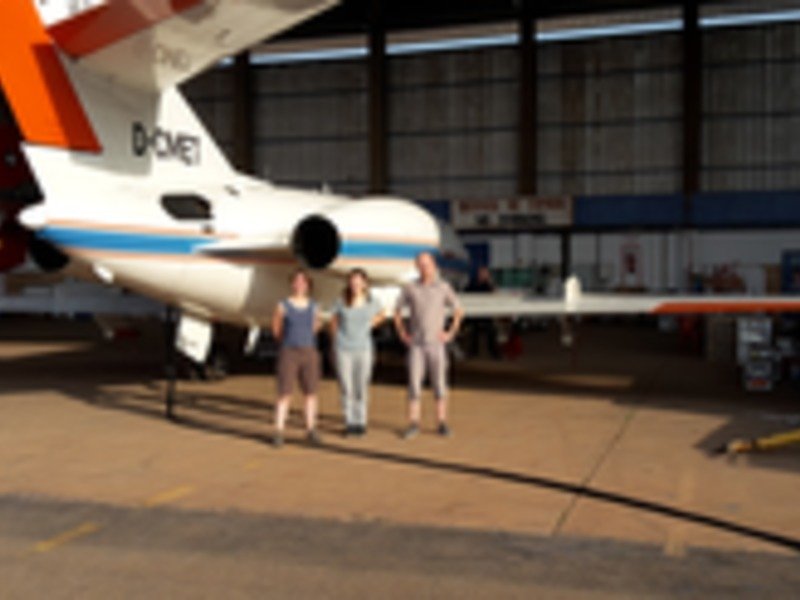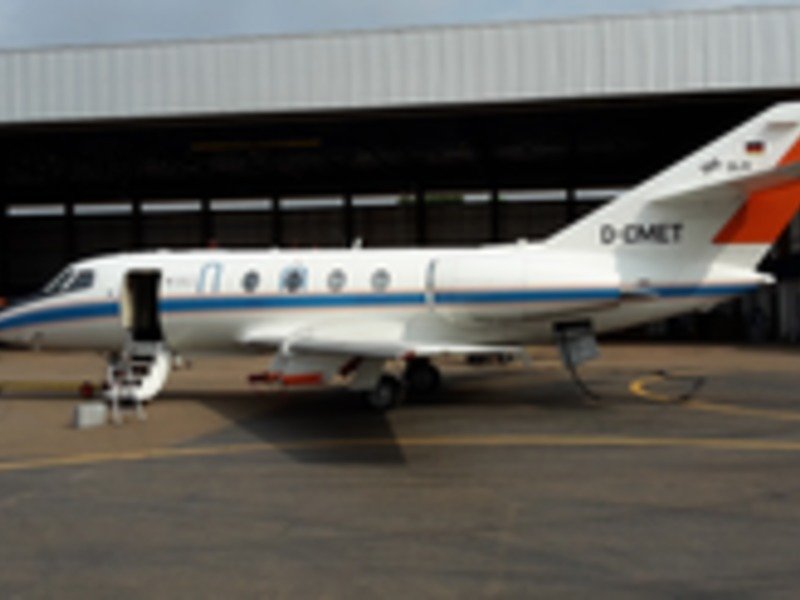Emission plumes over West Africa contain a high proportion of organic material
International measurement campaign over West Africa provides first results. Causes for enormous complexity in the multiple cloud layers still unclear
Within the framework of the EU project DACCIWA (Dynamic-aerosol-chemistry-cloud interactions in West Africa), scientists of the Max Planck Institute for Chemistry in Mainz, among others, are analyzing the composition of the air above the West African coast. In this context, the Mainz scientists focus on the suspended particles in the atmosphere such as sea salt, dust or soot, the so-called aerosol particles. Surprisingly, first results show that the aerosol in the emission plumes of the largest coastal cities, Accra, Abidjan, Lomé and Cotonou, contain a very high proportion of organic material and not, as previously suspected, a higher fraction of inorganic components such as sulfate or nitrate - a finding indicative of sources like domestic refuse, and agricultural waste incineration, burning of charcoal, and of biomass from fire clearings at low temperatures. The high amount of released aerosol particles at times causes turbidity and results in significant reduction of visibility in the air. As consequence, the ground receives less sunlight and the diurnal cycle of temperature, wind and clouds changes. For the first time the measurements have now revealed the tremendous complexity of the cloud formation and evolution mechanisms in the various near-surface and higher air layers. The reasons behind this remain unclear.


West Africa is experiencing profound changes. Rapidly growing populations, massive urbanization, uncontrolled forest degradation, complex meteorological factors, and barely controlled air pollution alter the composition of the atmosphere and therefore influence precipitation, weather and climate. However the consequences of air pollution for the land and its population, and how the different emission sources will change the region in the long-term still are inadequately researched. The EU funded project DACCIWA (Dynamics-Aerosol-Chemistry-Cloud Interactions in West Africa) with five years total running time aims to create bases for new and more accurate climate, weather and air quality models, which will allow for a more sustainable development policy. Scientists from 16 international research institutes are examining the links between weather influences, climate change and air pollution in DACCIWA, which is coordinated by the Karlsruhe Institute for Technology (KIT). In a field measurement campaign, for the first time, scientists are researching the entire chain of effects from natural and anthropogenic emissions on the West African atmosphere. From June to July 2016, they were on-site in Togo with three research aircraft, after data had been obtained in previous years by means of ground stations. For this, three highly equipped measurement locations were set up in the interior of the region. Several times a day weather balloon launches took place, in order to determine the urban emissions and to document the underlying meteorological background.
During the field deployment three research aircraft flew coordinated measurement flights: The Twin Otter propeller plane “Ice Cold Katy” of the British Antarctic Survey as well as the ATR from the Service des Avions Français Instrumentés pour la Recherche en Environnement (SAFIRE, an association of the French research institutes CNRS, Météo-France, and CNES) were used in addition to the Falcon of the German Aerospace Center (DLR). The different aircraft types each played out their particular strengths (wrt. altitude, speed, range) - however, they flew with similar equipment for trace gases, aerosols, clouds and meteorological parameters in order to provide accurate comparisons between different air layers.
Changing atmosphere over West Africa
The air in West Africa’s coastal region consists of a unique mixture of different trace gases, droplets and particles: Monsoon winds containing sea salt from the Southwest, Saharan north winds loaded with desert dust, residues from widespread biomass burnings from the South. Local emissions originate from charcoal fires, waste burning from the cities and power plants in the region, as well as from ship traffic, oil rigs and old engines. Even air masses from further distances, transported by the “Tropical Easterly Jet” and containing emission products, contribute to the chemical composition of the air to an extent previously not quantified. At the same time multi-layer cloud decks regularly form in the atmosphere, which have a great impact on the local weather and climate. What the aerosol particles are precisely composed of and what influence they have on the development and disappearance of the cloud layers is not well understood at present and is thus not implemented in current climate models.
Particle mass spectrometry in altitudes of up to 13 kilometers
From Lomé’s airport in Togo the research aircraft Falcon of the German Aerospace Center (DLR) took off into the West African coastal atmosphere carrying scientific instrumentation for trace gas and particle measurements from the DLR Institute of Atmospheric Physics, the Max Planck Institute for Chemistry and the CNRS Orleans (Centre National de la Recherche Scientifique). The aircraft flew through the cloud layers at different altitudes and steered into the emission plumes arising from the cities of Lomé, Accra, and Abidjan. Furthermore, the exhaust emissions of the ship traffic and from an oil rig off the coast of Ghana were examined.
During the flights the scientists from the MPI for Chemistry operated a state-of-the-art aerosol mass spectrometer which had to be specially configured for operation in the Falcon. The instrument measured the chemical composition of very small aerosol particles (the so-called fine particles) in real-time with high spatial resolution. “The measurement device proved itself under the very difficult measuring conditions at temperatures of up to over 40 degrees in the aircraft cabin,” says Stephan Borrmann, Director of the Department for Particle Chemistry at the Max Planck Institute for Chemistry, which is a joint institute with the Institute of Atmospheric Physics of the Johannes-Gutenberg University in Mainz. “We succeeded in collecting a unique data set during DACCIWA particularly due to the excellently coordinated cooperation of the three research aircraft from France, England, and Germany.”
Every day one or several cloud layers form above the coastal region of West Africa, which makes the area ideally suited as a laboratory to study the interactions between prevailing local and transported air pollution and the respective cloud characteristics. “The aerosol mass spectrometer enables us to chemically analyze the small aerosol particles directly and on-line in the aircraft,” explains Johannes Schneider, Head of the working group “Aerosol and Cloud Chemistry” at the MPI for Chemistry. “On the one hand, the chemical composition allows conclusions concerning the sources of the particles, and on the other hand, it can be deduced how well suited the particles are for cloud formation.”
However, the air pollution does not remain where it is emitted, but rather it moves further into the African continent. So the research aircraft followed the emission plumes from the large coastal cities of Accra, Abidjan, Lomé, and Cotonou on their way from the coast inland before they cross the savannah and forests towards the Sahara.
“In 2006 we already performed measurements on the aerosol and cloud physics over Burkina Faso (West Africa) up to an altitude of 20 kilometers by means of a special high altitude research aircraft. Today’s significantly improved and sophisticated measurement technology made possible the much more difficult chemical measurements of the fine dust particles during the DACCIWA campaign in Togo,” Stephan Borrmann explains the context of the DACCIWA campaign. “With the collected data the various physical and chemical processes in the West African atmosphere can be examined to characterize the background air from the Atlantic, Sahara and Sahel, as well as the effects of the increased land use by the population. We are extremely grateful for this very rare opportunity.”
The scientists will continue the research and data analyses concerning the influence of the atmospheric composition on cloud formation and air quality in West Africa until 2018.

